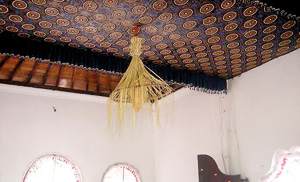Sunday Times 2
Ritual to ward off evil spirits
View(s):The Sri Dalada Esala Perahera ended with the water cutting ceremony and Daval perahera (Day Perahera) on August 30. Yet, the ceremonies associated with the perahera are not over. The Valiyak Mangalya is a Shanthi Karma – a dance performance that takes place at the Maha Vishnu Devalaya. It is done to ward off evil effects on those who took part in the perahera – the Diyawadana Nilame, Nilames of the devale, officers of the Sri Dalada Maligawa Etul Kattale and Pita Kattale, the dancers and drummers, the elephants and all others responsible for organising the perahera.

Gurunanse W.P. Simon Devanagala and his son Sumanatissa Nissanka
Gurunanse W.P. Simon Devanagala and his younger son Sumanatissa Nissanka from Hatarakorale near Aluthnuwara spoke to the Sunday Times about the ritual. Now 93, the Gurunanse has been performing the Valiyak Netuma since 1971. On the day after the Daval perahera, the Valiyak Mangalya or Valiyak Netuma or Hadda Valiyakuma is performed for seven days at the Hewisi Mandapaya of the Vishnu Devalaya.
Although the Gurunnanse is the main Yakdessa, his son Sumanatissa Nissanka is helping his father and will dance for six days. The Gurunnanse will dance only on the last day -September 6, which is today. Explaining further, Sumanatissa said, “Last Monday, August 31, the performance started at 7.30 p.m. and continued for about one and a half hours. A Gavara Mala – Pol Mala (coconut flower) is fixed on to the roof of the Hewisi Mandapaya where the ritual takes place. A Solos Magala is drawn with Sudu Kekulu (white raw rice), with 12 Sivili Walang (clay pots) with flowers, betel leaves and panduru (coins) placed on the ground, to perform the dance. The devalaya provides us with 32 neli of kekulu haal (raw rice), 12 sivili walang (clay pots), polgedi 16(coconuts), bulath kola 16 (betel leaves) panduru 16(coins) and mal (flowers). A Pirith Noola is also placed on the mal asana in front of the image of Vishnu Deiyo and we sing Kavi in praise of the deity and dance, whilst two drummers and four dancers perform.”
“On the second day the Gavara Mala is brought down and they dance round it. This performance starts at about 7.30 each day and continues for six days. On the sixth and seventh days the Sivili Abharana which is a flat plate made of wood decorated with silver wrapped in a blue cloth, the colour of the deity Vishnu is brought out by the Kapumahattaya or Kapurala and placed on the Sivili Walang.” On the sixth day the performance starts in the same manner but continues until the early hours of the next day. On the seventh day, (today), the performance will commence at 2 in the afternoon, the time the Daval Perahera started and end by about 5 in the evening. On this final day, the drummers and dancers will increase bringing the number to about 12.
 Sumanatissa spoke of how the Gara Yaka, a Yakdessa with a Devil mask comes in shouting asking for soru (rice), valapalam (bananas), kevum and other sweetmeats. “These are offered to the Gara Yaka. He then shouts and runs away. The Gavara Mala has to be brought down by us, but the people break the Gavara Mala as they wish to take a piece of it home believing it will bring good luck.” He said that there is a large crowd on the last day and it is difficult to control them when they jump up to grab the florets from the Gavara Mala.
Sumanatissa spoke of how the Gara Yaka, a Yakdessa with a Devil mask comes in shouting asking for soru (rice), valapalam (bananas), kevum and other sweetmeats. “These are offered to the Gara Yaka. He then shouts and runs away. The Gavara Mala has to be brought down by us, but the people break the Gavara Mala as they wish to take a piece of it home believing it will bring good luck.” He said that there is a large crowd on the last day and it is difficult to control them when they jump up to grab the florets from the Gavara Mala.
“Once the Garayaka leaves the Hevisi Mandapaya, the devotees tie panduru (coins) on the Jata Patiya(head gear with a long strap), offer pooja of fruits and flowers to the Vishnu deity. This pooja is done by the main Yakdessa taking on the role of the Kapu Mahattaya.”
There are two women known as Alaththi Amma clad in white. Olaganwatte Ralalage Punchimenike is one of them. She explained that their duty is to cook the rice in the devale premises which is to be offered to the deity and thereafter sit on a mat and respond to the ‘Ayubowewa’ greeting at the beginning of each sothra gayana (kavi) and dance item. She said that it is a duty as she has received a ‘kumburak’ (paddyfield) to perform this duty.
With this ritual, by five this evening, this year’s Sri Dalada Esala perahera in Kandy comes to an end.

